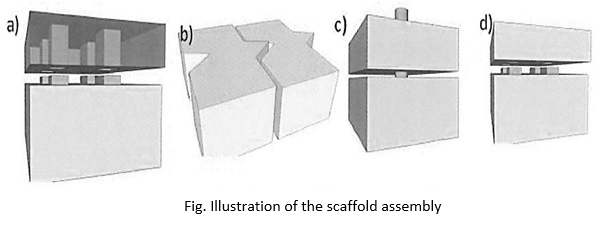Nanoclay-Polymer Scaffolds that Enhance Bone Regeneration (RFT-533)
Invention Summary
Researchers at NDSU have developed a versatile, modular scaffold for stem cell-based bone growth acceleration. The scaffold provides a structure that can be infused with stem cells, nutrients, cytokines, growth factors, therapeutics, bone morphogenetic protein. etc., enabling a highly adaptable treatment to address a wide variety of bone regeneration scenarios. Comprising small blocks that may be interconnected ahead of time to assemble a scaffold that approximates the size and shape of the bone void to be filled, the scaffold may be further modified during surgery, either to add blocks, or to cut away excess. The assembled scaffold will be firm, so won’t flow or slump out of the bone void prior to ‘setting’ (setting not being required for this technology). The scaffold itself is made of clay and resorbable polymers, which are entirely replaced by bone over time, and subsequently excreted. This technology may be used to develop products for rapidly stimulating natural bone formation in a variety of bone voids, including those created during surgery (e.g. spinal fusion and artificial joint implants), and those that result from injury or illness (such as non-union defects, complex fractures with associated bone loss, and areas where bone is excised to remove cancer).

Benefits
- Blocks may be pre-seeded with stem cells and placed in an incubator so surgical teams can specifically select scaffold blocks where healthy cells have become established. Assembling the pre-seeded blocks means that healthy and growing stem cells are present on the external surface, as well as throughout the bone filler in a 3D internal ‘grid’
- Pre-assemble any size or shape, allowing versatility and customization for any bone gap
- Easily assemble and modify in surgery, either to add or remove in response to the exact conditions found during surgery
- The scaffold is firm immediately, so the shape that is created before or during surgery won’t flow, expand, contract, or otherwise deviate from the shape created during surgery
- The scaffold components are clay and resorbable polymers, including synthetic polymers such as polycaprolactone and biopolymers such as chitosan and polygalacturonic acid, that are gradually replaced by bone, and excreted from the body
- Nano- and micro-porous with pore distribution that facilitates stem cell migration
Patents
This
technology is the subject of the issued US patent 11,541,150 and is available for licensing/partnering
opportunities.
Contact
NDSU Research Foundation
info(at)ndsurf(dot)org
(701)231-8173
NDSURF Tech Key
RFT, 533, RFT533
Inquire about this technology >